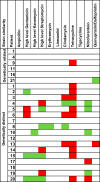Genome-Based Analysis of Enterococcus faecium Bacteremia Associated with Recurrent and Mixed-Strain Infection
- PMID: 29263205
- PMCID: PMC5824064
- DOI: 10.1128/JCM.01520-17
Genome-Based Analysis of Enterococcus faecium Bacteremia Associated with Recurrent and Mixed-Strain Infection
Abstract
Vancomycin-resistant Enterococcus faecium (VREfm) bloodstream infections are associated with high recurrence rates. This study used genome sequencing to accurately distinguish the frequency of relapse and reinfection in patients with recurrent E. faecium bacteremia and to investigate strain relatedness in patients with apparent VREfm and vancomycin-susceptible E. faecium (VSEfm) mixed infection. A retrospective study was performed at the Cambridge University Hospitals NHS Foundation Trust (CUH) between November 2006 and December 2012. We analyzed the genomes of 44 E. faecium isolates from 21 patients (26 VREfm isolates from 12 patients with recurrent bacteremia and 18 isolates from 9 patients with putative VREfm/VSEfm mixed infection). Phenotypic antibiotic susceptibility was determined using a Vitek2 instrument. Genomes were compared with those of a further 263 E. faecium isolates associated with bacteremia in patients at CUH over the same time period. Pairwise comparison of core genomes indicated that 10 (71%) episodes of recurrent VREfm bacteremia were due to reinfection with a new strain, with reinfection being more likely with increasing time between the two positive cultures. The majority (78%) of patients with a mixed VREfm and VSEfm infection had unrelated strains. More than half (59%) of study isolates were closely related to another isolate associated with bacteremia from CUH. This included 60% of isolates associated with reinfection, indicating acquisition in the hospital. This study provides the first high-resolution insights into recurrence and mixed infection by E. faecium and demonstrates that reinfection with a new strain, often acquired from the hospital, is a driver of recurrence.
Keywords: VRE; mixed infection; recurrence.
Copyright © 2018 Raven et al.
Figures


Similar articles
-
Genomics of vancomycin-resistant Enterococcus faecium.Microb Genom. 2019 Jul;5(7):e000283. doi: 10.1099/mgen.0.000283. Epub 2019 Jul 22. Microb Genom. 2019. PMID: 31329096 Free PMC article. Review.
-
Genomic Surveillance of Enterococcus faecium Reveals Limited Sharing of Strains and Resistance Genes between Livestock and Humans in the United Kingdom.mBio. 2018 Nov 6;9(6):e01780-18. doi: 10.1128/mBio.01780-18. mBio. 2018. PMID: 30401778 Free PMC article.
-
Utilizing genomic analyses to investigate the first outbreak of vanA vancomycin-resistant Enterococcus in Australia with emergence of daptomycin non-susceptibility.J Med Microbiol. 2019 Mar;68(3):303-308. doi: 10.1099/jmm.0.000916. Epub 2019 Jan 21. J Med Microbiol. 2019. PMID: 30663951
-
WGS of 1058 Enterococcus faecium from Copenhagen, Denmark, reveals rapid clonal expansion of vancomycin-resistant clone ST80 combined with widespread dissemination of a vanA-containing plasmid and acquisition of a heterogeneous accessory genome.J Antimicrob Chemother. 2019 Jul 1;74(7):1776-1785. doi: 10.1093/jac/dkz118. J Antimicrob Chemother. 2019. PMID: 30929020
-
A molecular study regarding the spread of vanA vancomycin-resistant Enterococcus faecium in a tertiary hospital in China.J Glob Antimicrob Resist. 2022 Dec;31:270-278. doi: 10.1016/j.jgar.2022.10.010. Epub 2022 Oct 20. J Glob Antimicrob Resist. 2022. PMID: 36273808 Review.
Cited by
-
Genomics of vancomycin-resistant Enterococcus faecium.Microb Genom. 2019 Jul;5(7):e000283. doi: 10.1099/mgen.0.000283. Epub 2019 Jul 22. Microb Genom. 2019. PMID: 31329096 Free PMC article. Review.
-
Diversification and Evolution of Vancomycin-Resistant Enterococcus faecium during Intestinal Domination.Infect Immun. 2019 Jun 20;87(7):e00102-19. doi: 10.1128/IAI.00102-19. Print 2019 Jul. Infect Immun. 2019. PMID: 31010813 Free PMC article.
-
Promiscuous, persistent and problematic: insights into current enterococcal genomics to guide therapeutic strategy.BMC Microbiol. 2024 Mar 28;24(1):103. doi: 10.1186/s12866-024-03243-2. BMC Microbiol. 2024. PMID: 38539119 Free PMC article. Review.
-
Investigating in vivo Mycobacterium avium subsp. paratuberculosis microevolution and mixed strain infections.Microbiol Spectr. 2023 Aug 16;11(5):e0171623. doi: 10.1128/spectrum.01716-23. Online ahead of print. Microbiol Spectr. 2023. PMID: 37584606 Free PMC article.
-
Clinical and Genomic Characterization of Recurrent Enterococcal Bloodstream Infection in Patients With Acute Leukemia.Open Forum Infect Dis. 2018 May 5;5(6):ofy107. doi: 10.1093/ofid/ofy107. eCollection 2018 Jun. Open Forum Infect Dis. 2018. PMID: 29977964 Free PMC article.
References
-
- Sievert DM, Ricks P, Edwards JR, Schneider A, Patel J, Srinivasan A, Kallen A, Limbago B, Fridkin S. 2013. Antimicrobial-resistant pathogens associated with healthcare-associated infections: summary of data reported to the National Healthcare Safety Network at the Centers for Disease Control and Prevention, 2009–2010. Infect Control Hosp Epidemiol 34:1–14. doi:10.1086/668770. - DOI - PubMed
Publication types
MeSH terms
Substances
Grants and funding
LinkOut - more resources
Full Text Sources
Other Literature Sources

